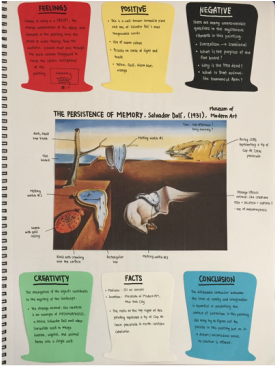

It is strange that a painting with these objects (melting clocks, dead trees, melting face), could make the viewer feel secure and nostalgic. The soothing textures in this painting are contrasted by the stark elements of the painting. In this mysterious light, the human quest to control time and memory is futile, like ants on the clock. The ants on the clock, for instance, probably represent mankind’s thoughts that the notion of time is a human concept. The unstated is more important than the obvious in this painting. This light source is either the permanence of time, or God, or whatever the viewer would attribute a higher power. However, the presence of light suggests a third presence between the viewer, the melting face in the painting, and the light source. However, it is difficult to judge from where this light generates. There are many shadows in this painting which allude to a source of light. This landscape suggests that there is some sort of cache for human experiences, and that possibly, human experiences add up to disassociations. The spatial arrangement of the objects creates a sense of isolation, for it does not seem that any two objects are connected or related. The clocks do not measure time, proven by their melting away. The memories that humans have are absorbed into the larger landscape of time. The title of this painting certainly alludes to Dali’s intentions the melting clocks and melting faces, against an unmovable background imply that human conception of time is temporary. The clocks are a feeble human attempt to capture time, and possibly the only accurate way to capture time is in one’s memory. The color is one of neutrality, and of soothing natural colors, juxtaposed by the unnatural surreal imagery. The repeated color of blue equates time with the ocean and sky in this manner, time is natural. The melting face represents this “fading away” of the individual in a landscape of time. We can view no more, for our finite time has elapsed, and we succumb to the infinite, we melt and fade away. We are limited by our concepts of time are we that pitiful creature nestled under a clock-blanket whose time has run out? If so, as the creature, we can view no more. Possibly the viewer is the melting half-face that is decomposing faster than the clocks that represent time’s permanence, and time’s passing. As an observer we view all from a desolate vantage point. The perspective of this painting is critical to its meaning. Most importantly, the clock faces seem to reflect the color blue, as well. The finite shares features with the infinite. The infinite sky and sea are blue and recognized. The theme of this painting is evident in both the title and the repeated imagery of melting clocks. Was this creature once from the sea or more related to the human viewer? A stark plank devoid of purpose, or purpose unknown. What remains, a stark table with a dead tree.

The sparsity is what draws the viewer to each individual object. The actual objects in the painting are not many. The theme of the infinite is explored by the structure of this painting.

Cliffs devoid of vegetation (life), yet a hint of blue, is this water? Is there hope of life? If so this is the only hope for all else the time for hope has come and gone. Then the beach, not infinite as it is void of all features. The structure of the painting relates a horizon which displays an infinite sky joining the infinite sea. Possibly, the half-face (that is most center in the painting) represents the viewer, and the melting clocks represent the passage of time. The composition of the painting is not centered, but rather spatial displacement of melting clocks surrounding a suggestion of a face that is immersed in this panorama. The title is the only seemingly related notion in this painting, for everything is Hence, the title of the painting is evident in the feelings that this painting elicits. The feelings that this painting brings out in the viewer include nostalgia, and also a dream-like confusion.


 0 kommentar(er)
0 kommentar(er)
